Non - Xeriscape.
Common Landscape Plants. Shrubs, Flowers, & Trees.
For The Arizona Desert Environment
Pictures, Photos, Images,
Descriptions, & Reviews.
Moth Orchid, Phalaenopsis.
We Are Proud Of Our SafeSurf Rating!
Click On Any Of The Following Links By Amazon.Com
For Books, & Videos About Wildflowers Of Arizona & The Southwest USA. No Obligation!
 |
| Moth Orchid, Phalaenopsis. Flowering Indoor Plant. March 21, 2012. Glendale, Arizona. |
|---|
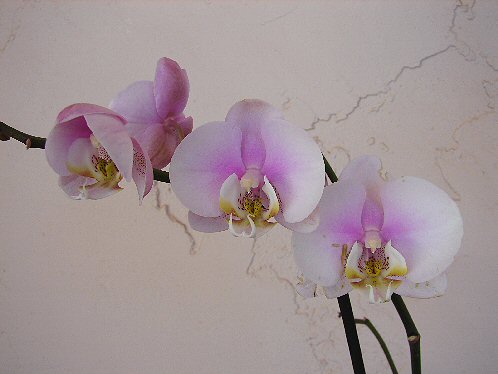 | 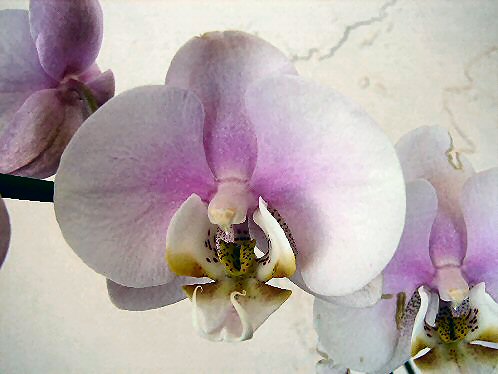 |
| Moth Orchid, Phalaenopsis. Flowers. | Moth Orchid, Phalaenopsis. Flower. |
|---|---|
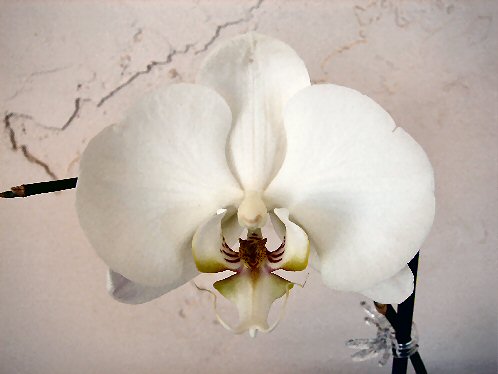 | 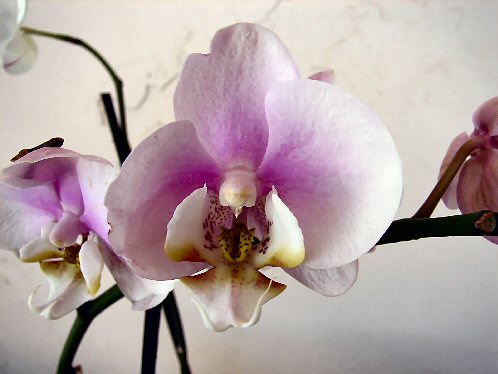 |
| Moth Orchid, Phalaenopsis. Flower. | Moth Orchid, Phalaenopsis. Flower. |
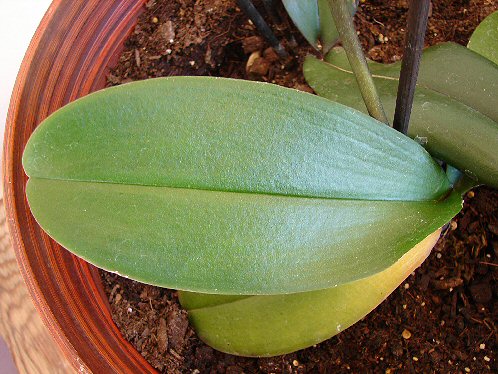 | |
| Moth Orchid, Phalaenopsis. Leaves. | Moth Orchid, Phalaenopsis. Leaf. |
Moth Orchid.
We wish to thank Wikipedia, the free encyclopedia for some of the information on this page. We share images and information with Wikipedia. Phalaenopsis, abbreviated Phal in the horticultural trade, is an orchid genus of approximately 60 species. Phalaenopsis is one of the most popular orchids in the trade, through the development of many artificial hybrids. Phalaenopsis is probably a reference to the genus Phalaena, the name given by Carolus Linnaeus to a group of large moths; the flowers of some species supposedly resemble moths in flight. For this reason, the species are sometimes called Moth orchids. Phalaenopsis are native throughout southeast Asia from the Himalayan mountains to the islands of Polillo, Palawan and Zamboanga del Norte in the island of Mindanao in the Philippines and northern Australia. Orchid Island of Taiwan is named after this genus. Most Phalaenopsis are epiphytic shade plants; a few are lithophytes. In the wild, some species grow below the canopies of moist and humid lowland forests, protected against direct sunlight; others grow in seasonally dry or cool environments. The species have adapted individually to these three habitats. Possessing neither pseudobulbs nor rhizome, Phalaenopsis shows a monopodial growth habit: a single growing stem produces one or two alternate, thick, fleshy, elliptical leaves a year from the top while the older, basal leaves drop off at the same rate. If very healthy, a Phalaenopsis plant can have up to ten or more leaves. The inflorescence, either a raceme or panicle, appears from the stem between the leaves. They bloom in their full glory for several weeks. If kept in the home, the flowers may last two to three months. In some instances the flowers may last up to 6 month! Growing Phalaenopsis Plants:
Phalaenopsis Orchid Plants Are Easy To Grow! Its hard to mess up with this plant! Temperature: The ideal temperatures for Phalaenopsis range between 55 and 85 F. For ideal growing try to maintain 60 at night and between 75 and 80 F. during the day. Cool night time temperatures in the fall encourage flower spike initiation. However, once the flower spike is developed, wide swings in temperature can cause unopened buds to drop off. Temperatures in excess of 90 F. can slow down their growth. We try to keep the temperatures at about 75 F. Humidity: Phalaenopsis are of a monopodial growth without any pseudobulbs to help store moisture. For this reason, it is important to provide good humidity. Phalaenopsis do well with moderate humidity levels. The ideal levels range between 50 and 75% relative humidity. In a heated home, you should set your plants on a shallow tray filled with gravel and water. This will help to keep the humidity near your orchids at the acceptable levels. But DON'T let the plants roots sit in the water! Watering: Generally speaking; moth orchids should not be dry to the point of wilting. They should be watered thoroughly, and then not again, until the soil or growing media is almost, but not completely, dry. How often you water will depend on the type of soil or growing media your orchid is growing in, and its growing environment. Once every week to 10 days is a good way to start your watering schedule. Water your Phalaenopsis early in the morning. This insures complete water evaporation through the foliage, as well as the crown by nightfall. Water with rain, distilled, or reverse-osmosis water as the mix approaches dryness. NEVER use water that has been softened by a water softener (it usually contains salt). During winter months, with the heat on in your home, the lower, inside your home humidity, will mean you�ll water more frequently. Don�t let your soil or growing media dry to the point of wilting your plants. Do not get any water on the flowers, as this will shorten their blooming time. Fertilizer: A slow release fertilizer or a liquid plant food, with equal parts of N-P-K, (14-14-14) applied at its recommended rate every second time you water, should work well. During blooming season, a blooming plant formula with elevated phosphorus levels (i.e. 10-30-20), would be best. But, we recommend NOT fertilizing while the plant is flowering During winter months you should reduce the liquid fertilizer applications to once a month. Flowering: The flowers of the Phalaenopsis Orchid have a very superb long life. And, you can often urge a second flowering from each spike with a just simply, a timely pruning. Here's how you do it! When the last flower of the flower spike fades, you should examine the spike, looking for some small fleshy bumps or nodes. Once you find them, from the base of the flower spike count out 3 nodes (count only the green fleshy nodes � ignore any that are dried out). Then cut the flower spike one inch above the third node. If your plant is strong & healthy, and the blooming season is not too late, one or two of the nodes may produce a new spray of fresh blooms in a few short weeks. Extending your flowers for nearly 6 months of the year, on the same plant. If there is no response, or the flower spike turns brown, cut the flower spike off near the base of the plant where it emerged. Phalaenopsis have been known to normally bloom 2 to 3 times per year; once they have reached a mature size. Sometimes the flower buds (not the flowers) may dry up and drop off the plants without ever opening. Check the following: Is the room too hot? Is the light level too low? Is the plant too dry or too wet (causing root rot, this is the most common cause)? Are you using softened water instead of clean water? Are you using too much fertilizer? Are the plants being subjected to a cool draft? Is the plant near strong fumes such as new carpets, refinishing woodwork, etc.? Buds droping off is a common problem with Phalaenopsis. Fortunately, there is almost always a reason, that if you can change, you can solve the problem! Light & Shade Requirements: Between 1,000 to about 1,500 foot - candles is the ideal light intensity required for growing Phalaenopsis. Generally speaking then, Phalaenopsis do not require too much light to grow well. If growing your Phalaenopsis in a windowsill, an eastern exposure is the best. You should try not to burn the plant, by allowing too much sunlight to shine directly on the plant. It is best to provide some shade, such as with a sheer curtain, allowing a little more light to hit the plant from the months of December through the middle of February. Potting Or Re - Potting: Because your Phalaenopsis is being watered frequently, the the soil or growing media will break down about once per year. This means that you MUST repot your Phalaenopsis once a year! Another reason to re-pot is that your plant has outgrown its container. Spring or fall is considered the best time to repot because the temperature is generally mild, preventing shock to your plant. We recommend using a medium grade orchid bark mix for plants in 5" pots and above. However, many growers are using sphagum moss as their media of choice. It seems to work best for smaller Phalaenposis plants, as it dries out more evenly. Either choice is OK!
How To Repot.
Pests: Phalaenopsis Orchids should be monitored for aphids, mealybugs, mites, scale, and slugs. These can usually be removed with a soft cloth and soapy water.
Quick Notes:
Height: 18 - 36 inches high & about 12 - 20 inches wide.
Flowers: Phalaenopsis hybrids flowers range is size from 2" to nearly 5" in diameter. Colors include white, pinks, lavender, and yellow in both solid colors and mixes of stripes and spots. Individual blooms can last as long as 3 months. Flowers open sequentially at 2-5 day intervals along an arching spike.
Flowering Time: December through May.
Leaves: Green, heavy, leathery, fleshy, 8 to 12 inches long. 3 to 4 inches wide.
Found: Origin: southeast Asia from the Himalayan mountains to the islands of Polillo, Palawan and Zamboanga del Norte in the island of Mindanao in the Philippines and northern Australia.
Elevation: 0 to 26,089 Feet.
Habitat: Landscaping: Moist, Acid Soil, 6.6 to 7.5 (neutral).
Miscellaneous: Phalaenopsis Orchids should be monitored for aphids, mealybugs, mites, scale, and slugs. These can usually be removed with a soft cloth and soapy water.
|
We Are Proud Of Our SafeSurf Rating!
Click On Any Of The Following Links By Amazon.Com
For Books, & Videos About Wildflowers Of Arizona & The Southwest USA. No Obligation!
| © 1966 - Present, Audrey, Eve, & George DeLange |
